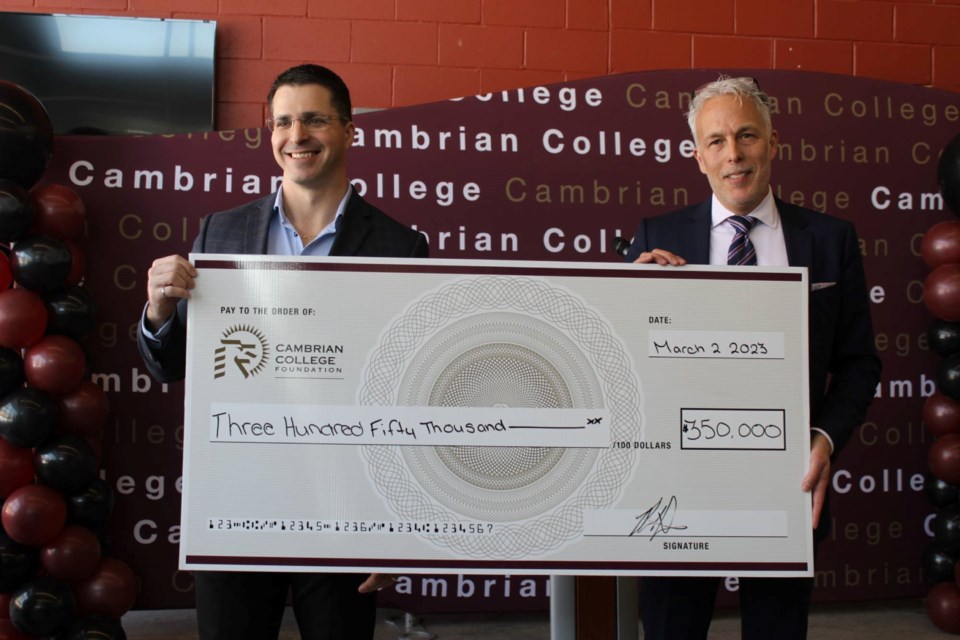Growing up, Matteo Neville was the kind of kid who spent his time taking apart motors and engines just so he could figure out how they worked.
He was fascinated by robotics and technology, electronics and programming, so when he decided to return to school as a mature student, he was immediately drawn to Cambrian College’s mechatronics program.
“I was always interested in how you could apply technology and computers to that mechanical side,” said the 27-year-old. “So when I was looking at coming back to school, that program just kind of matched exactly with my interest area.”
Now, in the second year of the three-year program, Neville is getting his fill of all things mechatronics.
Working on multiple applied research projects at the school, Neville said he’s been involved in everything from very technical, electronic projects to large-scale mechanical engineering ventures, while also taking on manufacturing technology, 3D printing, CNC machining, and more.
“It’s really exciting,” Neville said. “It’s a really wide range of opportunities I get to be a part of.”
This fall, Neville and students like him will have another state-of-the-art lab at their disposal, one that specializes in battery-electric vehicle (BEV) technology.
Construction is currently underway on the new BEV (battery electric vehicle) lab at the Glencore Centre for Innovation on Cambrian’s Sudbury campus. It's expected to be complete by September.
Once operational, the 5,600-square-foot facility will serve as a hub for BEV prototyping and testing electric powertrains and batteries. Data gleaned from the work done there is expected to help support BEV manufacturers and end users in the mining industry where widespread adoption of battery-electric vehicle technology is now underway.
To help usher in this new era of education and innovation, Sudbury Integrated Nickel Operations – a Glencore Company, announced on March 2 funding of $350,000 for the lab, which will go toward construction and operational costs, procuring equipment, and bursaries for Indigenous students who are enrolled in technology, engineering and skilled trades programs.
Shawn Poland, Cambrian’s interim president, called the nickel miner “one of the most significant supporters in Cambrian’s history.”
“Their generous gift will enable us to advance our mission and support industry not just in the North, but around the world,” Poland said.
“It’s certainly going to be a transformative gift for so many, and the college, and our partners, enabling us to push the boundaries of what’s possible within the BEV space.”
Peter Xavier, vice-president of Sudbury INO (Integrated Nickel Operations), noted that Glencore donated $2 million to help launch the Glencore Centre for Innovation — in turn secure naming rights to the facility — when it opened in 2012.
Sign up for the Sudbury Mining Solutions weekly newsletter here.
In providing this newest endowment, Xavier said, the company is aiming to advance technology it will be using shortly in its Sudbury mining operations, particularly at its Onaping Depth project.
Now under construction, the $1.3-billion nickel development is located beneath Craig Mine in the Sudbury community of Onaping, located northwest of the city proper.
High-grade nickel is expected to be produced from the mine until 2035.
When Sudbury INO approved the project in 2018, it decided to make it an all-electric vehicle mine.
“At the time, when we did that, it was quite a leap of faith,” Xavier said. “The market was still developing, but we were adamant that that's where we wanted to go.”
Five years on, the market has advanced considerably, he noted, and the company will soon be receiving its first battery-electric mining vehicles from MacLean Engineering, which will be integrated into its operations later this year.
“Going deep after mining here for almost 100 years, you can imagine that the challenges are growing, and innovation is obviously a key part of that,” Xavier said.
“So BEV is one aspect of them, but there’s a lot of firsts that we’re having to encounter when looking at our future, whether it’s Onaping Depth or the next opportunity.”
Xavier said he fully expects Glencore to benefit from the research and development that will take place at the new lab, expressing the hope that Cambrian would become a “beacon globally to attract the best and the brightest right here into Sudbury to learn about BEVs.”
New concepts developed at the lab could result in spinoff businesses and technologies that Glencore can tap into down the road.
“The seedlings of those ideas, those innovations might be started here, and I see that we’ll benefit from that in the future,” he said.
“As we go deeper and deeper, and encounter new challenges, we’re going to need some of those innovations to meet those challenges of the future, and so that’s what I’m really excited about.”
Matteo Neville still has a year left in his studies before he’ll embark on a job search.
In the meantime, he’s excited about the new applied research projects this new BEV lab will enable.
Cambrian is already a leader in its field because of the breadth and high-end quality of the technology available to students. The BEV lab will be the icing on the cake for future learners.
“This infusion will allow us into even more cutting-edge technologies in the BEV sector, so that will allow our students to get hands-on experience with those technologies, which, as far as I’m aware, aren’t present in any other research environment in colleges in Canada,” Neville said.
“So it’ll be really exciting to see what our students can do with that knowledge and learning opportunity, and carry forward into industry.”




